[fusion_builder_container hundred_percent=”no” equal_height_columns=”no” menu_anchor=”” hide_on_mobile=”small-visibility,medium-visibility,large-visibility” class=”” id=”” background_color=”” background_image=”” background_position=”center center” background_repeat=”no-repeat” fade=”no” background_parallax=”none” parallax_speed=”0.3″ video_mp4=”” video_webm=”” video_ogv=”” video_url=”” video_aspect_ratio=”16:9″ video_loop=”yes” video_mute=”yes” overlay_color=”” video_preview_image=”” border_color=”” border_style=”solid” padding_top=”” padding_bottom=”” padding_left=”” padding_right=”” type=”legacy”][fusion_builder_row][fusion_builder_column type=”1_1″ layout=”1_1″ background_position=”left top” background_color=”” border_color=”” border_style=”solid” border_position=”all” spacing=”yes” background_image=”” background_repeat=”no-repeat” padding_top=”” padding_right=”” padding_bottom=”” padding_left=”” margin_top=”0px” margin_bottom=”0px” class=”” id=”” animation_type=”” animation_speed=”0.3″ animation_direction=”left” hide_on_mobile=”small-visibility,medium-visibility,large-visibility” center_content=”no” last=”true” min_height=”” hover_type=”none” link=”” border_sizes_top=”” border_sizes_bottom=”” border_sizes_left=”” border_sizes_right=”” first=”true” type=”1_1″][fusion_text]
Annaikoá¹á¹ai Seal: Is it Tamil BrÄhmÄ«?
Prasad Fonseka
Figure 1: Annaikoá¹á¹ai Seal and the Sealing [inverted image][1]
Introduction
A team of researchers from the Jaffna University launched archaeological excavation of a megalithic burial site at Annaikoá¹á¹ai in Jaffna Peninsula which commenced in 1980. In 1981 the discoverer of a steatite seal with a BrÄhmÄ« inscription and some other symbols was a significant milestone. The first attempt to decipher was done by Dr Kartigesu Indrapala of the Jaffna University. His reading was kovetem, which denotes the chief or king. However, overall it was considered as a Tamil Inscription and furthermore a Tamil BrÄhmÄ« inscription. This was considered as the basis for firm proof of existence of Tamil BrÄhmÄ« inscriptions in Sri Lanka. This matter needs further meticulous careful examination which has arisen of several anomalies. Thus:
- The oldest Tamil inscriptions in Jaffna Peninsula dates back to the 11th[2] A seal in Tamil in the 3-2 centuries B.C. has whetted the curiosity of the researches. Why there are no Tamil inscriptions for over a millennium thereafter?
- To decipher the inscription koveteá¹, the last letter had been considered as an anusvÄra [á¹], Tamil language has no anusvÄra.
- In India the oldest Tamil BrÄhmÄ« inscription, known as MÄá¹…galam Inscription, has been dated to the 2nd century B.C.[3] Under the circumstances is it logical to name it as a Tamil BrÄhmÄ« inscription, which predates the South Indian inscriptions?
Discussion on early Deciphering
This seal is engraved with three non-BrÄhmÄ« symbols and down below contain three BrÄhmÄ« letters. Indrapala deciphered the BrÄhmÄ« inscription as koveteá¹.[4] Apparently, it is to have a meaningful Tamil word, he has sort assumed the dot like section above the third letter as a BrÄhmÄ« symbol and therefore, it is accounted as a part of the BrÄhmÄ« inscription. He had assumed it as an anusvÄra [á¹] and deciphered it with the last BrÄhmÄ« letter [3] as taá¹. If there is an anusvÄra as he has sought to assume, that categorically indicates it is not a Tamil inscription.
Seals and sealings from Akurugoda and elsewhere have adduced concrete evidence that a seal could exist without the name of the chief. The epithet chief mentioned it is not precisely specific. When there is an inscription that bears on a seal, it contains the name of the user.
Raj Somadeva has opined that it is keveta, which is the PrÄkrit version of the Sanskrit word kevarta, which means ‘the fisherman’.[5] Since the objective of using a seal is to authenticate or authorised a transaction, the word ‘fisherman’ may not be the best apposite word. Several other scholars have also proposed several other readings based on their assumptions. Hitherto, the reading of Indrapala prevails as the acceptable reading in epigraphy.
Tamil BrÄhmÄ« Inscription – Distinctive Identification
On palaeographical evidence available the Inscription could be dated to 3-2 century B.C., which concurrent with the dating of the site. At the outset, it has been described as a Tamil BrÄhmÄ« inscription. It is theoretically accepted anomaly that a Tamil BrÄhmÄ« inscription should have at least one of the four Tamil BrÄhmÄ« letters. This inscription contains no such evidence. The dating is the other most important factor. It is known that the oldest Tamil BrÄhmÄ« inscription is MÄá¹…galam Inscription which has been dated to the 2nd century B.C. vide fn 3. In the aforesaid circumstances, it is required to look into the veracity of the statement since it indicates Sri Lanka had older inscriptions than in South India. The above assumption could be accepted only if Tamil BrÄhmÄ« writing has been first originated in Sri Lanka and not in South India. There are no historical records or archaeological records to surmise such a premise. Sri Lanka has a well-documented history in written form and the authenticity of those records have been established.[6] Accordingly, there is no way to assume that the Tamil community of Sri Lanka is older than their counterparts in India and also has conducted research to develop the language. Furthermore, there are five inscriptions[7] by Tamils during the pre-Christian period. All the inscriptions are in Sinhala PrÄkrit as the other Sri Lankan inscriptions and their names were also PrÄkrit, which confirms the Tamils were already integrated into the main stream. like the other similar groups who migrated to Sri Lanka. Accordingly, having a Tamil inscription is a matter to be thoroughly investigated.
Other Anomalies which could be comparatively deciphered
Sri Lanka has over 1000 of pre-Christian era BrÄhmÄ« inscriptions in comparison to South India. The evolution of letters due to usage could be assessed fairly precisely. It can be observed with clarity that the letter ka during the period 3-2 century B.C. was a symmetrical cross [Swiss Cross]. A letter similar to the first letter of the seal during that period was ra.
Figure 2: Letters ra and  ka (darakatisa puta) (575, [8] Vol. 1) 3-2 century B.C.
Figure 3: ra in Maharaja (703, Vol. I) 3-2 century B.C.
It can also be observed that there are two letters similar to the first letter which is visible in the inscriptions of the 1st century B.C. The present reading of the letter as ka is due to that similarity (Figure 5).
It is necessary to note two kinds of ra in Sri Lanka: a straight vertical line (Figure 3) and a wavy vertical line (Figure 2). In Indian inscriptions it was generally a wavy line since Indian inscriptions have combined letters. When forming a combined letter with ra the vertical part of that letter becomes wavy. Sri Lankan inscriptions have no combined letters and therefore, there is no proper standard envisaged.
Figure 4: Girnar 1, line 5 DevÄnaá¹piya priyadasi raja: pri and rÄ are in black squares
Figure 5: The word kabura [paddy field] in Vol. II, No. 8 by King BhÄtikÄbhaya (22 B.C.- 6 A.D.)
Figure 6: Letters ri ka ri (Vol. II, No 3) during King Kuá¹akaṇṇa Tissa (44-22 B.C.)
It is clear that if the first letter in the seal is deciphered as ka, it should be the ka in the 1st century B.C., and certainly not the ka in 3-2 century B.C. If that letter is ka then the other two letters also should belong to the 1st century B.C. From the inscriptions of the 1st century B.C. the shapes of the other two letters could be determined.
Figure 7: Section of Inscription No 10 (Vol. II): va and ta are in squares and ka in a circle. The first letter is also depicted on the right.
From the Figure 7, the shapes of the three letters in the 1st century B.C. could be identified. There is not an iota of a doubt that the letters va and ta are quite evidently different. The variant letters found in Figure 5 and Figure 6, also looks similar to the first letter of the seal, but are of the 1st century B.C. That means the seal could not belong to the 1st century B.C. and therefore, the letter in question cannot be ka. This is again falls in line with the dating of the site.
Figure 8: An enlarged image of the first letter
An enlarged image has proved beyond doubt that it is more evident, that the letter cannot be ka in the 1st century B.C., since the ka during that period had a curved lower part. This letter evidently contains no such curve. A careful closer perusal reveals that there is no dash that cuts through the vertical line. On the right-hand side there is no extension of the dash. Perhaps the small dash like thing on the left side is some other distortion that is extended up to the bottom of the letter. The letter looks like a vertical line with a dash at the top which can clearly be distinctly identified as medial e.
Analytical Study: Deciphering of the Inscription
Both Indrapala and Somadeva deciphered the second and the third letters as va and ta. The shapes of letters correspond to the 3-2 century B.C. and the reading could be accepted. Therefore, the first letter also should correspond to a letter in 3-2 century B.C. and the only letter that matches is ra. Such a ra is found in the Figure 3. Since there is a dash to the right at the top it can be deciphered as re and the inscription on the seal can be deciphered as Revata, which is a name found in Sri Lankan BrÄhmÄ« inscriptions.[9] It means and denotes the seal belongs to RÄ“vata [proper noun]. It is also a PrÄkrit word.
In Sri Lanka commonly, the dash of re [to add the medial vowel e] is attached little below the top of the vertical line of ra as depicted below. However, the dash found in the inscription is attached at the top of the letter as in the case of Asoka BrÄhmÄ«.
 Â Â Â Â Â Â Â
                 Â
          
Revata in 265Â (Vol.1) Â Â Â Â Â Â Â Â Â Â Revaya in 405 (Vol.1) Â Â Â Â Â Â Â Â Â Â Â Â Â Â Â Â Â Â Â Â Â Â Â Reta in 719 Vol.1)
Figure 9: re in Sri Lankan inscriptions (3-2 century B.C.)
Delhi Topra North 1 Pillar [the word dereti]
Figure 10: re in Asoka inscriptions
This could even have originated in North India. Therefore, before concluding another aspect needs to be examined with clarity. That is whether the making of the seal was done in India and whether it represents the ka which in vogue in India in 3-2 century B.C. The study of the evolution of the Indian ka is required to re-examine this stance with preciseness. From Asoka Inscriptions it can be observed that the ka is similar in India and in Sri Lanka.
Figure 11: Section of Dhavli Middle 1 by King Asoka (269-228)
Figure 12: The word King Kaniska (c.100 A.D.) is marked in the black square
It can be observed from the inscription on the Statue of Kaṇiṣka[10] (Figure 12) that the Indian ka has not much developed for more than three centuries. This categorically confirms that the Indian letters have not taken a rapid change as in Sri Lanka and the letter under reference is even not an Indian ka. [11]
 Conclusion
The present study has envisaged that the inscription on the Annaikoá¹á¹ai Seal is not a Tamil BrÄhmÄ« inscription. It is a PrÄkrit inscription having the name Revata [RÄ“vata], which is a common name found in Sri Lanka and North India.
This seal either could be a Sri Lankan or a North Indian seal, which can be dated to the 3-2 century B.C.
References
Bopearchchi, O; Wickramasinghe, R., 1999 Ruhuna; An ancient Civilisation re-visited, Colombo,
CORPUS INSCRIPTIONUM INDICARUM Inscriptions of Asoka, New Edition by E. Hultzsch, VOL. I, 1922, THE CLARENDON PRESS, OXFORD
Cūḷavaá¹sa  Part I and II, Translated from PÄli to German by Geiger W., The English translation, Rickmers, c. Mabel.; Ceylon Government Information Department, Colombo, 1953
Epigraphia Zeylanica Vol. VII, 1984Â Archaeological Survey of Sri Lanka.
http://ratnawalli.com/2014/11/excavating-sri-lankan-archaeology-with-raj-somadeva-part-3/I
http://www.archaeology.lk/http:/www.archaeology.lk/wp-content/uploads/2011/02/Dinithi-Volume-1-Issue-4.pdf
http://www.tnarch.gov.in/epi/ins1.htm [Accessed on 10/01/2017]
https://en.wikipedia.org/wiki/Annaicoddai_seal – Annaikoá¹á¹ai seal [Accessed on 12/01/2017]
Inscriptions of Ceylon Vol. I, Edited by S. Paranavitana, Archaeological Survey of Sri Lanka.
Inscriptions of Ceylon Vol. II Part I, Edited by Paranavitana, Archaeological Survey of Sri Lanka.
MahÄvaá¹sa, ed. Geiger, Wilhelm, 1912 Government Press, 1986 Reprint
Secondary Sources
Fonseka, Prasad.,
-2006 Standardisation and Pronunciation of Some of the Ancient Sinhala Words, National Archaeological Symposium.
-2008: Environmental and Physical Factors in the Study of Inscriptions Journal of Royal Asiatic Society – Sri Lanka – (URL-http://www.royalasiaticsociety.lk/journals/2010/N.S.53/Environmental-and-Physical-Factors-in-the-Study-of-Inscriptions..pdf)
-2011 The BrÄhmÄ« Script and the Style of Sinhala writing (Sinhala), Ä€rya VibhÅ«á¹£aṇa – Felicitation of Prof. Abaya Aryasinghe
The Origin and the Evolution of BrÄhmÄ« Script, (in press)
Falk, Harry, 2014 Owners’ graffiti on pottery from Tissamaharama, ZEITSCHRIFT FÜR ARCHÄOLOGIE AUSSEREUROPÄISCHER KULTUREN, BAND 6.
Pushparatnam, P.,
-2002 Ancient Coins of Sri Lankan Tamil Rulers, Bavani Patippakam, Puttrr, Jaffna.
Key Words: Sri Lanka, Jaffna, Brahmi, Tamil Brahmi, Annaikottai, Annaikoddai, seal
[1] https://en.wikipedia.org/wiki/Annaicoddai_seal[02/01/2019]
[2] https://en.wikipedia.org/wiki/Tamil_inscriptions_in_Sri_Lanka [17/4/2020].
[3] Early Tamil Epigraphy From the Earliest Times to the 6th Century A.D. By Iravatham Mahadevan, An Overview by S. Swaminathan (http://www.indian-heritage.org/swaminathan/ tamilscripts/index.html#slide) [13/02/2019]
[4] Indrapala, Karthigesu (2007). The evolution of an ethnic identity: The Tamils in Sri Lanka C. 300 BCE to C. 1200 CE. Colombo: Vijitha Yapa Publications.
[5] http://ratnawalli.com/2014/11/excavating-sri-lankan-archaeology-with-raj-somadeva-part-3/I [12/09/2020]
[6] Introduction to MahÄvaá¹sa § 2. The Trustworthiness of the Ceylon Chronicles, xii.
[7] Those are 94, 356, 357, 480 (Vol. I) and Epigraphical Notes, 2886
[8] All Sri Lankan BrÄhmÄ« inscriptions quoted are from Inscriptions of Ceylon Vol. I and II, edited by Senarath Paranavitana, unless stated to the contrary.
[9] Revata was one of the monks who spearheaded the second council (DÄ«pavaá¹sa, 4.54-56). For other monks and individuals by that name please see http://www.palikanon.com/english/pali_ names/r/revata.htm.
[10] https://en.wikipedia.org/wiki/Kushan_Empire#/media/File: [20/02/2020]
Kanishka_enhanced.jpg
[11] The fast change in the Sri Lankan script in the 1st century is due to the writing of Tripiá¹aka in 89 B.C. (Origin and the Evolution of BrÄhmÄ« Script, Prasad Fonseka, in press)
[/fusion_text][/fusion_builder_column][/fusion_builder_row][/fusion_builder_container]



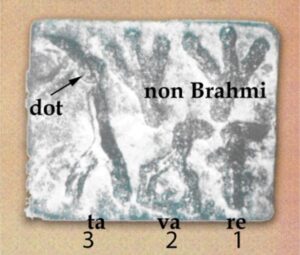
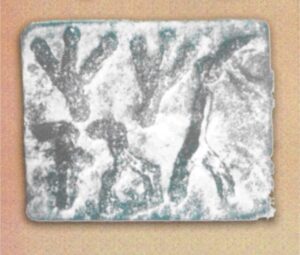





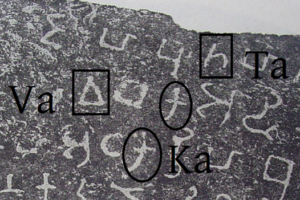

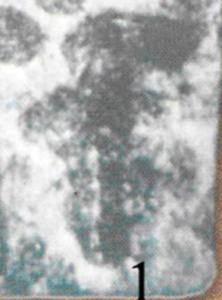


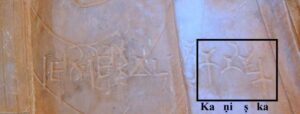
Is there any evidence of glass manufacture in ancient Sri Lanka . Ingots found in a ship wreck are probably glass manufactured from paddy husk . Professor sonadeva may know
The Mangulam Tamil Brahmi inscription which dates back to at least the 2nd century BC has a Brahmi Ku which does not arise from a symmetrical cross; the horizontal line in that letter cuts the vertical line higher up similar to this Ko/Ke letter. So the palaeographic dating suggested in this article is not sound. Likewise the 2nd letter here is without a doubt a Brahmi Ve, not Va. The author has misread Indrapala and Somadeva, who both agree on the Ve letter.
The author asks why there are no further Tamil inscriptions for a millennium after. Clearly the peninsula was Prakritised by then. However, there is a clear megalithic Dravidian substratum and this can be seen in Dravidian words in the earliest Prakrit inscriptions such as Vel, Marumakan, Parumaka and Parumakal. Koveta is consistent with this.
Dear Mr Fonseka
With great respect to you, I find it difficult to understand why the Sinhalese Archaeologists are always biased towards claiming everything and anything to be Sinhalese or Prakrit.
I am a student and who is not biased. But Unfortunately beginning with Bhikku Mahanama who wrote the Mahawamsa with his own Harry Potter type imaginations to glorify Buddhism and the Sinhala Language upto Gnanasara Thera are destroying any chance of Tamils and Sinhalese living in Peace.
You cannot deny you are a result of the Prince Viyaya and his followers marrying Tamil women from Pandya Kingdom.
It might be better for you all to start saying that Tamil Language evolved from Sinhala Language.
Shame on you.